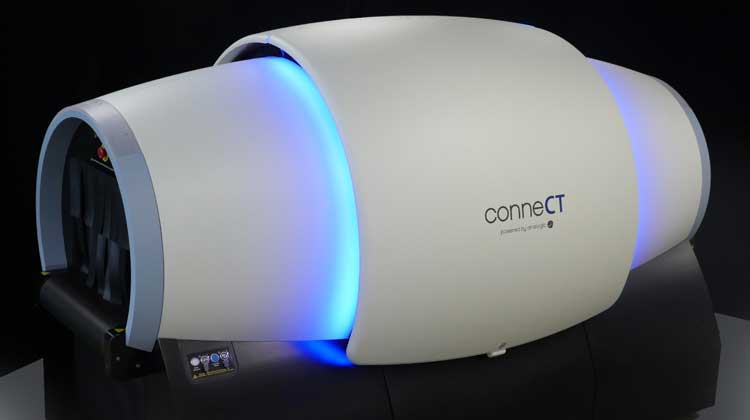
At a December Homeland Security Committee hearing, Chairman Mike McCaul (R-Texas) suggested the Transportation Security Agency (TSA) switch as soon as possible from X-ray scanners to computed tomography (CT) technology at airport checkpoints.
The benefits of such a rapid switch would undoubtedly allow screeners at passenger checkpoints to better scan stuffed bags and packages, while moving traffic through security at a faster rate. In simple terms, it turns what was a two-dimensional X-ray image into a 3-D image for screeners, allowing a better view of everything in carry-on baggage. In medical terms, McCaul noted that it’s the difference between an X-ray and an MRI—and he’s not wrong.
And the medical connection is quite applicable. For 50 years, Peabody, Mass.-based engineering firm Analogic has provided imaging technology with its original equipment manufacturer (OEM) partners in the medical field.
Since around 9/11, however, Analogic has also been in the security business, providing screening equipment for airports. Their next-generation system called ConneCT is making its way through the approval process and is designed to eventually eliminate time-consuming steps of emptying carry-on bags at security checkpoints. It will also improve screeners’ abilities to better separate threats from harmless items in luggage, according to Mark Laustra, vice president for Global Business Development and Government Relations at Analogic.
“The machine uses high-powered algorithms to differentiate between explosives and innocent material,” Laustra told Homeland411. “So the more we learn about how passengers pack their bags, the better the system is.”
The technology offers screeners a three-dimensional look at bag contents from different angles giving them a more complete picture of what’s inside—something TSA is unable to do with its current two-dimensional technology. They’ve also made it adaptable to better respond to new threats.
“The ConneCT was designed to accept third-party algorithms, and why that’s important is … if there’s a threat that TSA learns about through intelligence, that machine has to be ready to detect that threat,” Laustra said. “A lot of times the government or the regulator will go back to the manufacturer and say ‘Hey, we have this new threat and we need you to develop an algorithm for it.’ Our system was designed so that anybody can write this algorithm for it.”
He added that giving the government flexibility in writing algorithms can offer quicker solutions. “Speed is of the essence when you’re talking about new threats,” Laustra said. “TSA can’t wait a year and a half for a solution; they have to have a solution within weeks or months.”
Analogic isn’t a stranger to this technology; they’ve been at the forefront. They’ve provided CT technology for checked baggage for years, and about 10 years ago were poised to offer a CT solution for security lanes.
“We partnered with L3 [Technologies] to build the first checked baggage systems, realizing that TSA didn’t have that tool in the tool box for checkpoint,” Laustra said. “We started to design our CT system for the checkpoint, and we came out with a product called Cobra, which we debuted in about 2007.”
At the time, he said, TSA was preparing to deploy its second-generation multiview X-ray system—still a two-dimensional system. “Our product—the Cobra—which used CT, we scaled it down for use at checkpoint, but it was still rather large, rather heavy, and it still was quite slow, so even though we had the first CT for checkpoint, it was really not practical for a security checkpoint.”
Now, about 10 years later, threats have evolved. Second-generation, two-dimensional screening is now ready to transition again, and things have changed over the past decade. Particularly with higher checked bag fees and changing traveler habits, Laustra said passengers now pack differently, and TSA must see through the clutter. The new screening procedures implemented in October requiring all electronics to be removed in non-Pre-check lanes has added another layer for screeners as well. It helps screeners get a better view, but it takes passengers even longer to get through screening.
Since last year, ConneCT has achieved TSA Tier II certification—necessary to demonstrate the technology at a checkpoint lane in an airport. In order to be placed in a lane at an airport, the system still has to go to the TSA Systems Integration Facility (TSIF). “Once you put your lab certified machine there … you have to go through the evaluation to determine the best way to use a machine,” Laustra said.
Worldwide, the systems are already seeing use, however. Amsterdam Airport Schiphol is currently screening bags at passenger checkpoints with ConneCT.
The next step, Laustra said, is having the machines deployed as part of the TSA’s Innovation Task Force Program. “It’s been described as an incubator for new technology,” Laustra said. Add the TSA’s Automated Screening Lane (ASL) being deployed nationwide, and it’s a boon for busy travelers as well as safety, with a quicker but more comprehensive trip through security.
“Right now, airports around the world are seeing about 150 to about 180 passengers per hour when you factor in the X-ray and the walk-though metal detector,” Laustra said. “With the CT and the ASL, together you’ll never really have to stop the belt because the ASL is designed to automatically divert your bag off into a secondary search area, so the belt never really has to stop if they use it correctly.” The result, he said, is that screening lanes could possibly see throughput of 250 to 300 passengers per hour.
© 2017 Homeland411